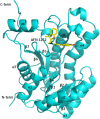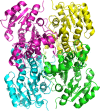AFN-1252 is a potent inhibitor of enoyl-ACP reductase from Burkholderia pseudomallei--Crystal structure, mode of action, and biological activity
- PMID: 25644789
- PMCID: PMC4420531
- DOI: 10.1002/pro.2655
AFN-1252 is a potent inhibitor of enoyl-ACP reductase from Burkholderia pseudomallei--Crystal structure, mode of action, and biological activity
Abstract
Melioidosis is a tropical bacterial infection caused by Burkholderia pseudomallei (B. pseudomallei; Bpm), a Gram-negative bacterium. Current therapeutic options are largely limited to trimethoprim-sulfamethoxazole and β-lactam drugs, and the treatment duration is about 4 months. Moreover, resistance has been reported to these drugs. Hence, there is a pressing need to develop new antibiotics for Melioidosis. Inhibition of enoyl-ACP reducatase (FabI), a key enzyme in the fatty acid biosynthesis pathway has shown significant promise for antibacterial drug development. FabI has been identified as the major enoyl-ACP reductase present in B. pseudomallei. In this study, we evaluated AFN-1252, a Staphylococcus aureus FabI inhibitor currently in clinical development, for its potential to bind to BpmFabI enzyme and inhibit B. pseudomallei bacterial growth. AFN-1252 stabilized BpmFabI and inhibited the enzyme activity with an IC50 of 9.6 nM. It showed good antibacterial activity against B. pseudomallei R15 strain, isolated from a melioidosis patient (MIC of 2.35 mg/L). X-ray structure of BpmFabI with AFN-1252 was determined at a resolution of 2.3 Å. Complex of BpmFabI with AFN-1252 formed a symmetrical tetrameric structure with one molecule of AFN-1252 bound to each monomeric subunit. The kinetic and thermal melting studies supported the finding that AFN-1252 can bind to BpmFabI independent of cofactor. The structural and mechanistic insights from these studies might help the rational design and development of new FabI inhibitors.
Keywords: AFN-1252; Burkholderia pseudomallei; FabI; Melioidosis.
© 2015 The Protein Society.
Figures



 ) [Fig. 3(a)]; and 0 nM (•), 5 nM (▪), 20 nM (▴), 40 nM (▾), 80 nM (♦), and 160 nM (
) [Fig. 3(a)]; and 0 nM (•), 5 nM (▪), 20 nM (▴), 40 nM (▾), 80 nM (♦), and 160 nM ( ) [Fig. 3(b)].
) [Fig. 3(b)].




References
-
- Hayden HS, Lim R, Brittnacher MJ, Sims EH, Ramage ER, Fong C, Wu Z, Crist E, Chang J, Zhou Y, Radey M, Rohmer L, Haugen E, Gillett W, Wuthiekanun V, Peacock SJ, Kaul R, Miller SI, Manoil C, Jacobs MA. Evolution of Burkholderia pseudomallei in Recurrent Melioidosis. PLoS One. 2012;7(5):e36507, 1–14. - PMC - PubMed
-
- Wiersinga WJ, Currie BJ, Peacock SJ. Melioidosis. N Engl J Med. 2012;367(11):1035–1044. - PubMed
-
- Limmathurotsakul D, Peacock SJ. Melioidosis: a clinical overview. Br Med Bull. 2011;99:125–139. - PubMed
Publication types
MeSH terms
Substances
LinkOut - more resources
Full Text Sources
Other Literature Sources

